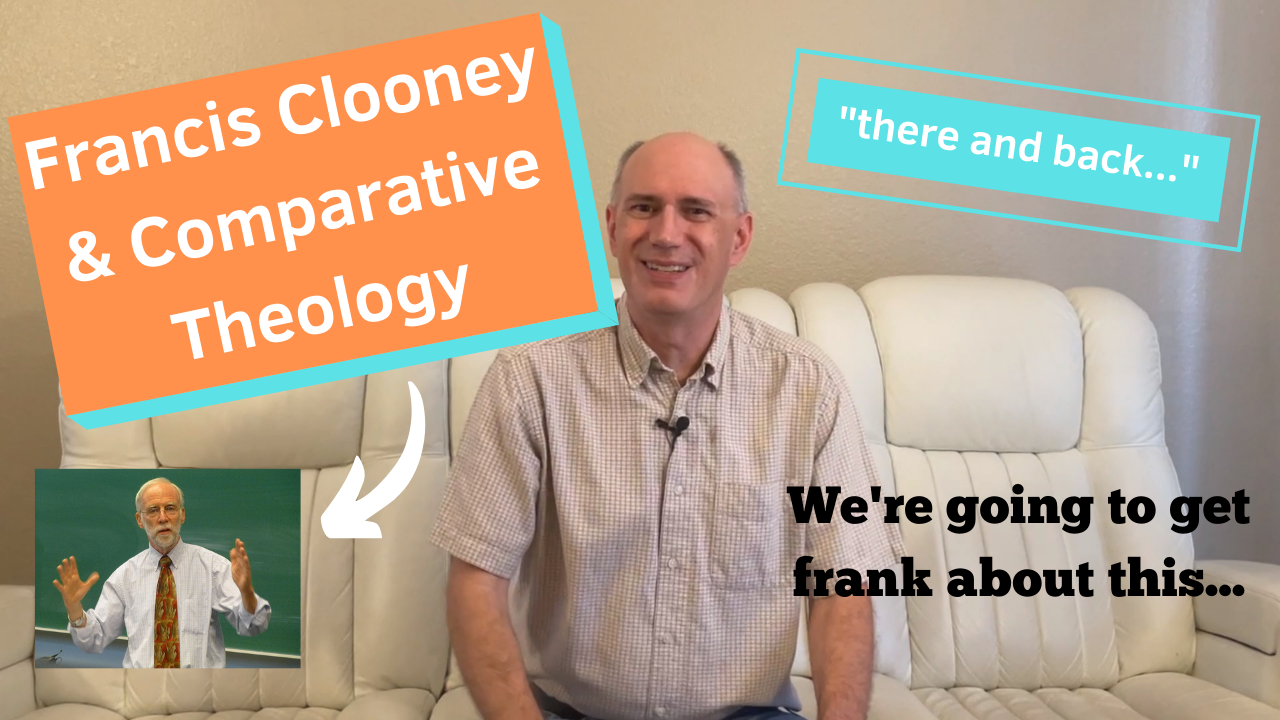11/03/2021 – Francis Clooney and Comparative Theology

What is comparative theology and just who in the world is this Frank Clooney guy? These are serious questions that need to be taken…seriously. [fake cough] I feel like I’m having a bad hair day or something, as if that’s like even possible. Don’t laugh. I have a, uh, smaller, uh, shampoo budget than most of you. Okay, enough nonsense. Today we’re going to sort all of this stuff out. Stick with us! This is TenOnReligion.
Hey peeps, it’s Dr. B. with TenOnReligion. This video is closed-captioned here on YouTube and the transcript is available at TenOnReligion.com. If you like religion and philosophy content one quick thing I need you to do is to smash that sub button because it really helps out the channel. I also have a ko-fi linked in the description if you’d like to help support the channel and help me keep this puppy going.
About Frank Clooney
Okay, Francis Clooney, (he goes by Frank) is a Roman Catholic priest and scholar who is a specialist in Hinduism and comparative theology. The phrase “comparative theology” has been around at least since 1700 but there have been several versions of it over the last three centuries. Nearly 30 years ago, Clooney basically started the contemporary version of comparative theology which is version 3.0? uh, 5.0? 6.3? I don’t know. I lost count. He taught at Boston College over two decades and is now at some place called Harvard University. He has written many important books and articles on comparative theology and comparing Christianity and Hinduism. I’m only going to talk briefly about two of them just to get you an idea about what this is all about. These are Hindu God, Christian God: How Reason Helps Break Down the Boundaries between Religions from 2001 and Comparative Theology: Deep Learning Across Religious Borders from 2010. It’s tough limiting this episode to only these two works because Divine Mother, Blessed Mother: Hindu Goddesses and the Virgin Mary from 2005 and The Future of Hindu-Christian Studies: A Theological Inquiry from 2017 are also very good. But we have to keep this episode manageable. I’ll start by giving a brief overview of Hindu God, Christian God followed by a more expansive, but still brief, presentation on Comparative Theology.
Hindu God, Christian God
Okay, Hindu God, Christian God compares Christian and Hindu theologians from the far past to the recent past on several key questions about theology proper, as in the study of God. These include the existence and identity of God, the embodiment of God, and lastly revelation. How do theologians from these two traditions answer and explain such important issues? The intellectual dialogue Clooney presents is rich and is a great example of how such a conversation can proceed fruitfully. The book seriously [These are serious questions that need to be taken…seriously.] seriously calls into question the idea that theology should be a single-tradition internal discussion. In fact, Clooney argues, quite successfully I might add, that there are no good reasons today to keep theological traditions separate from one another. While there may be some beliefs, practices, and creeds or doctrinal statements that could be recognized as particular or unique to one tradition, almost all of what counts as important theological thinking is actually shared across a number of religious boundaries. Since there are theological issues which many traditions think about in their own way, why not think about them together and see what can be gained from the conversation? There are two main methods this can be accomplished: one, either inside-out, or two, outside-in. In the inside-out method one starts with the particulars of one’s faith tradition and then moves outward towards a dialogue with other willing conversation partners. In the outside-in method one starts with common questions or issues and then cycles or spirals inward into beliefs which are more specific in nature. In this book, Clooney does a good job of explaining both methods and how they relate to these key questions he addresses in the book about theology and the study of God.
About the book Comparative Theology
All right. That was a good example as an intro to the concept. On to Comparative Theology where Clooney provides further rationale for the method along with more examples of how this is to be done. There are three main sections of this book which basically are “the what,” “the how,” and “the results.” The first section, “Starting Points,” is where Clooney explains what comparative theology is along with some historical and contemporary figures for context. The second section, “Doing Theology Comparatively,” is where he explains how to do comparative theology while providing some examples. The last section is “The Fruits of Comparison” where he explains the resulting benefits of this whole endeavor.
Starting Points
The first chapter largely attempts to carve out a niche for comparative theology by distinguishing it from related methods. So, there’s sort of a mapping project going on here regarding different terminology of methods that have developed over the past half century. Comparative religion is where the subject, the researcher or investigator, assumes a neutral position while comparing two or more traditions. Theology of religions assumes the subject is a religious adherent who interprets other religions, um, tries to make sense of them, and ultimately defines what they mean from the perspective of their tradition. Interreligious dialogue refers to conversations between willing subjects from differing traditions. Comparative theology is sort of a combination of all of these. The starting point is one’s own tradition. One is exposed to something or some aspect of another religious tradition that is somehow similar, such as a text, an image, a practice, a doctrine, an important historical figure and so on. One then engages in an in-depth study of both in the home tradition and in the other tradition. It is reflective and contemplative for the purpose of seeing “the other” in light of “our” tradition and seeing “our own” tradition in light of “the other.” What can we learn from our own tradition by seeing something similar in another tradition? Can the fresh perspective help us better understand ourselves? In most cases the answer is usually “yes.” In the next two chapters Clooney provides some background by way of both historical and contemporary figures he sees as related, but sadly we don’t have enough time to get into all of those details right now.
Doing Theology Comparatively
In the second section, “Doing Theology Comparatively,” Clooney writes about comparing religious texts. One thing I have to emphasize here is that Clooney largely focuses his version of comparative theology, which is essentially the original contemporary version of it, with texts as being the main source material for the comparative process. This is difficult because not everyone (more like, very few) will learn to read and research in other languages to the same extent that Clooney does with Indian languages. More recent comparative theologians are not always as sacred text-based as Clooney is, meaning they use other sources for the comparison such as practices, rituals, doctrines, philosophies, works of art, and so forth. There are two great chapters here though, one on comparing Christianity and Hinduism and one which gives practical examples. I have to say the practical examples provided are excellent. One example compares Mary the mother of Jesus with the Hindu goddesses of Lakshmi and Devi. Another example compares Mary in the New Testament with an understanding of Mary through Muslim eyes in the Qur’an. (Many Christians have no clue that there is more information about Mary in the Qur’an than in the New Testament gospels). And yet a third compares both of these to Sojourner Truth in African-American theology to change one’s understanding of religious freedom. It’s really fascinating stuff.
The Fruits of Comparison
The third section, “The Fruits of Comparison,” gets into detailing the benefits and results. What does this all mean? What is the point? The main thing one has to keep in mind is that comparative theology as Clooney envisions it emphasizes the particular rather than the general. It doesn’t compare Christianity with Hinduism, but rather one small aspect that one finds in common. Clooney gives the example of the imago Dei, the idea that humans are created in the image of God. One can investigate how this is understood in Christianity and then repeat the investigation for Hinduism. After such comparison, one might not completely understand Christianity or Hinduism, but one will have a better understanding of what the imago Dei means for both traditions. Clooney doesn’t mention this, but another example might be investigating how the gender of God is portrayed in the Ancient Near East in its various polytheistic forms prior to monotheistic Judaism and comparing that with how the gender of God is portrayed in Buddhism in ancient Chinese culture. In such an investigation one would learn a lot about the relationship between gender and divinity if one’s background were Jewish for example. Comparative theology is really about learning on a smaller scale. One ultimately ends up back “home,” but with a fresher and enhanced understanding after the “there-and-back” investigative experience.
Wrap-up…let’s be “frank”
So, what can be said about this? In a good way, one becomes both an insider and an outsider. One is an insider in one tradition, but because one enhances the understanding of the home tradition through sources outside of the home tradition, one becomes an outsider. This is good because this new insider-outsider status widens the theological perspective. And frankly…hehehe frankly…his name is “Frank” Clooney…hehehe…sigh. And honestly, in this globalized world, we need more bridges and fewer walls.
So, what do you think about Frank Clooney’s presentation of comparative theology? Don’t hold back. Be frank in your comments. Leave a comment below. Until next time, stay curious. If you enjoyed this, support the channel in the link below, please like and share this video and subscribe to this channel. This is TenOnReligion.


